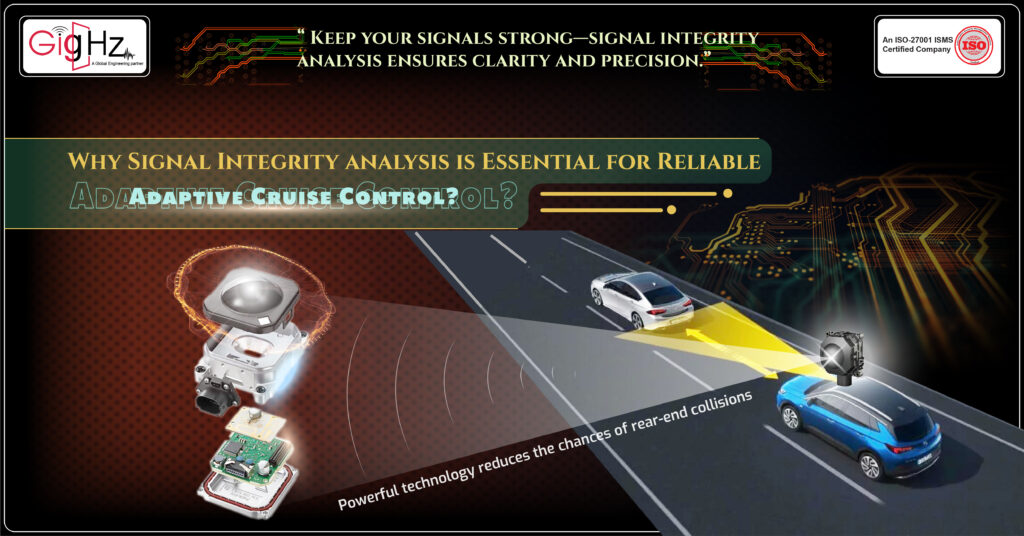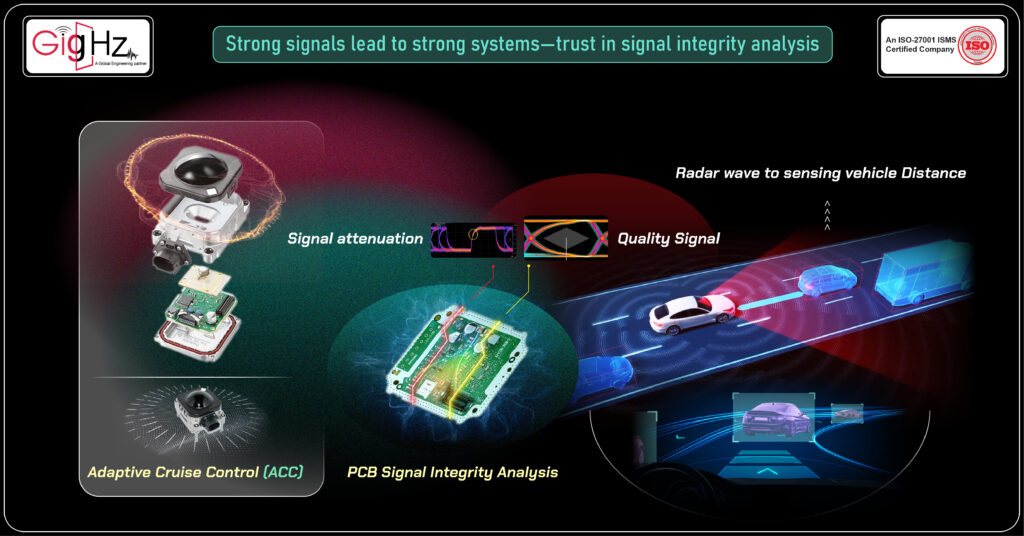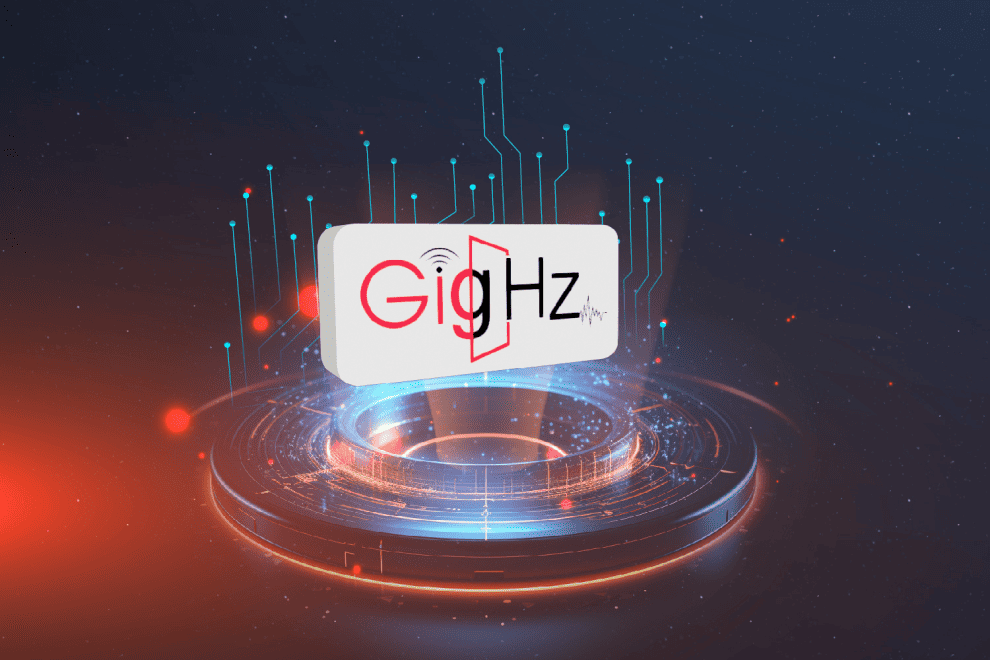Why Signal Integrity analysis is Essential for Reliable Adaptive Cruise Control?
- Posted On:
- September 5, 2024
- Category:
- Analysis & Simulation

Signal Integrity Analysis
In today’s world, the rising number of road accidents and their serious effects highlight a critical problem.
Despite progress in vehicle safety technology, we still face a major challenge in reducing accidents and saving lives.
Every year, countless people are injured or killed in traffic collisions, showing just how urgent the need for effective solutions is.
Among these solutions, Adaptive Cruise Control (ACC) is a key player.
ACC helps by automatically adjusting a vehicle’s speed to keep a safe distance from the car in front.
This simple yet powerful technology reduces the chances of rear-end collisions and makes driving safer.
It’s a crucial tool in our ongoing effort to lower accident rates and protect lives on the road.
To make ACC work reliably, it’s essential to ensure that the signals it uses are clear and accurate. This focus on signal integrity is vital for improving road safety and addressing the ongoing challenge of preventing traffic-related injuries and fatalities.
A survey conducted by the National Highway Traffic Safety Administration reveals that 94% of vehicle accidents result from driver error.
To help prevent such collisions, advanced driver assistance systems like adaptive cruise control are designed to support drivers in avoiding potential crashes.
However, for ACC to function effectively, it depends crucially on signal integrity. The accuracy and clarity of signals from sensors and radar are not just important—they are essential.
Without clear and reliable signals, ACC cannot properly adjust vehicle speed or maintain a safe distance from the car in front. This can lead to failures in the system, compromising safety and increasing the risk of accidents. Therefore, maintaining optimal signal integrity is absolutely critical for the ACC system to work as intended and play its vital role in reducing traffic-related injuries and fatalities.
Let’s delve into deeper!
Understanding Signal Integrity Analysis in automotive systems

ACC systems use radar waves and sensors to detect and track the position and speed of vehicles ahead. These systems constantly emit and receive signals, which are then processed to determine how far away the car in front is and how quickly it is moving.
If the signals from the radar or sensors become degraded—due to interference, noise, or attenuation—the data they provide can become inaccurate. For instance, if the distance measurement is incorrect because of signal distortion, the ACC system might miscalculate how far to stay behind the vehicle in front. This miscalculation can lead to unsafe driving conditions, such as the system maintaining too close a distance or not adjusting speed appropriately.
To uphold signal integrity in ACC systems, adhere to these best practices,
- Use controlled impedance traces and minimize discontinuities in the circuit layout. Implement effective shielding and filtering techniques to reduce EMI.
- Regularly test signal paths using TDR and frequency-domain analysis to ensure that signal integrity is maintained throughout the system.
- Utilize simulation tools to predict and address potential signal integrity issues during the design phase.
Why Signal Integrity analysis is Essential for Reliable Adaptive Cruise Control?

Here’s an in-depth explanation of the potential issues:
- Inaccurate Distance Measurement
Impact: Poor signal integrity can lead to inaccurate distance measurements between vehicles. ACC systems rely on radar and other sensors to determine the distance to the vehicle ahead by measuring the time it takes for emitted signals to reflect back.
Signal attenuation, caused by interference or degradation, can reduce the strength of the reflected signals, leading to incorrect distance calculations. For example, if the radar signal is weak or distorted, the system might misinterpret the distance, resulting in a vehicle following too close or too far behind the vehicle in front.
Electromagnetic interference (EMI) and noise can corrupt the signals received by the sensors. This can lead to erroneous readings and affect the system’s ability to accurately gauge the distance. Inconsistent or noisy data can cause the ACC system to miscalculate the following distance, potentially leading to unsafe driving conditions.
- Delayed or Erroneous System Response
Impact: ACC systems must process sensor data and adjust vehicle speed in real-time. Poor signal integrity can introduce delays or errors in this processing, affecting the system’s responsiveness.
If the signal integrity is compromised, it can lead to delays in data transmission and processing. If radar signals are intermittently lost or corrupted, the ACC system may not receive timely information about changes in traffic conditions, resulting in a delayed response. This can lead to the vehicle not adjusting speed quickly enough in response to sudden changes, such as the vehicle in front braking sharply.
Signal degradation can cause the ACC system to make incorrect adjustments to the vehicle’s speed. For instance, if the data is inaccurate due to poor signal quality, the system might overestimate or underestimate the required speed adjustment, which can lead to sudden, inappropriate acceleration or braking. This not only affects driving comfort but also increases the risk of accidents.
- Compromised Safety and Reliability
Impact: The primary function of ACC systems is to enhance safety by maintaining a safe following distance and improving driving comfort. Poor signal integrity undermines these functions, potentially compromising overall vehicle safety.
In extreme cases, significant signal integrity issues can lead to system failures or malfunctions. For example, persistent signal issues might cause the ACC system to disengage or fail to operate correctly, leaving the driver without the assistance intended to prevent collisions.
When the ACC system is unable to accurately measure distances or respond appropriately due to poor signal integrity, the risk of rear-end collisions and other accidents increases. This can lead to dangerous driving conditions and undermine the safety benefits of the ACC system.
Poor signal integrity in ACC systems can result in inaccurate distance measurements, delayed or erroneous system responses, and compromised safety and reliability. Ensuring high signal integrity is essential to maintaining the effectiveness of ACC systems and achieving their intended safety benefits.
Performing Signal Integrity Analysis

Radar signals are vital for Adaptive Cruise Control (ACC) systems to gauge the distance and speed of vehicles ahead. Ensuring signal integrity in the radar transmission lines and the associated circuit layout is essential for the ACC system to function accurately and reliably.
Radar signals are transmitted through specific circuits known as transmission lines on a PCB (Printed Circuit Board). These lines must maintain signal integrity to ensure accurate data processing by the ACC system.
The layout of the PCB circuit impacts signal integrity by affecting how signals are routed and how components interact. Proper layout design is crucial for maintaining high-quality radar signal transmission.
Trace Routing: Ensure that radar signal traces are routed with minimal length and are kept as straight as possible to reduce signal loss and distortion. Avoid routing traces near high-frequency or high-power components that can introduce interference.
Ground Planes: Implement solid ground planes beneath radar signal traces to provide a low-impedance return path and reduce signal noise. Ground planes also help in maintaining consistent impedance and shielding signals from external interference.
Via Usage: Minimize the use of vias (holes in the PCB that connect different layers) in radar signal paths, as vias can introduce impedance discontinuities and signal reflections. When vias are necessary, use them sparingly and ensure they are properly designed to maintain signal integrity.
Final Thoughts
PCB design plays a critical role in ensuring signal integrity and power integrity in high-speed circuit design. It is essential to follow design rules and use EDA tools like Altium Designer for both pre-layout and post-layout analysis. By utilizing signal integrity simulation and analysis tools, designers can identify and address potential issues such as crosstalk, impedance mismatch, and coupling in the PCB layout.
Through simulation results and modeling, designers can optimize PCB trace routing, termination schemes, and interconnect architectures to achieve good signal integrity.
By running post-layout signal integrity analysis, designers can validate the signal line and signal return paths to ensure reliable signal and power integrity in the integrated circuit and board design.
Ready to collaborate? Find a time that fits your schedule! https://calendly.com/gighz/30min
Table of Contents
Latest Post
Get Customized Engineering CAD Design Service

Book a Free Consultation Call
Partner with Gighz and bring your most innovative design concepts to life. Our engineering cad services accelerate development so you can focus on your big vision.
